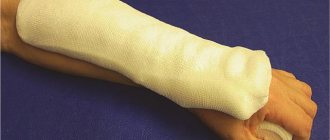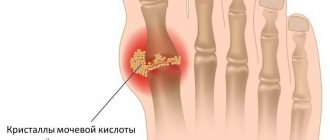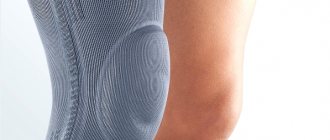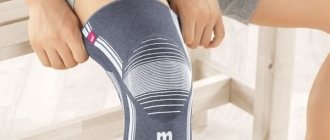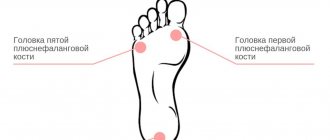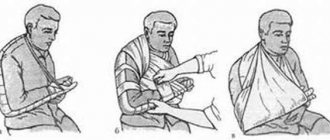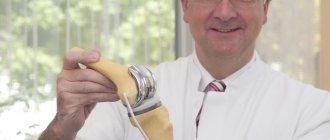- After what time
- How to remove a splint
- Doctors
- Make an appointment
- Reviews
A plaster or polymer fixing bandage - a splint - can only be removed according to a doctor's instructions. Perhaps not even the one who prescribed immobilization. There are certain deadlines for removing the splint. They depend on the time of callus formation and healing of the bone fracture. In order to remove a plaster or polymer bandage, special tools are used that are used in the traumatology treatment room.
| Service | price, rub. | Promotion price, rub. | Record |
| Removing plaster and polymer splints | 700 rub. | Sign up | |
| Removal of circular plaster and polymer dressings | 1000 rub. | Sign up |
Our doctors:
Krasnov Sergey Aleksandrovich Practical work experience: 27 years.
Position held in the clinic: orthopedic traumatologist
The main specialty and specialization of the specialist for which admission is conducted: traumatology, orthopedics.
Proficient in methods of surgical and conservative treatment of acute injuries of the musculoskeletal system of an isolated, combined and combined nature.
Make an appointmentAsk a specialist a question
Moroz Kirill Sergeevich Practical work experience: 9 years.
Position held in the clinic: orthopedic traumatologist
The main specialty and specialization of the specialist for which admission is conducted: traumatology, orthopedics.
Proficient in methods of surgical and conservative treatment of acute injuries of the musculoskeletal system of an isolated, combined and combined nature.
Make an appointmentAsk a specialist a question
Features of the technique
A plaster splint is applied for significant bruises and ligament damage. It is also used after the reduction of joints in case of dislocations, as well as for various types of fractures. If there are contraindications to the application of blind plaster, this technique is also used. For this purpose, a special room is allocated in surgical departments. It contains the necessary materials and equipment for the procedure.
Applying a plaster splint has a number of advantages. It fits tightly and evenly to the body, is easily removed and hardens very quickly. If there are fragments that have been compared by a surgeon or traumatologist, the splint will hold them well.
Gypsum is calcium sulfate. It is well dried at a temperature of 100 to 130 ºС. Thanks to this, the material grinds well, forming a white powder. Gypsum is a hydrophilic substance. To prevent it from becoming saturated with moisture, it is stored in a well-closed container made of metal or glass.
It is best to use M400 grade gypsum for medical purposes. It hardens in 10 minutes. at a temperature of 15 ºС. This period is reduced to 4 minutes if the room temperature is 40 ºC. The quality of gypsum is checked using a series of tests. The powder should be evenly and finely ground. When mixed with water, the smell of hydrogen sulfide should not be released.
Types of ankle splints
Ankle splints made of various materials.
The most common braces are called “Jones bandages”. They are designed to secure the foot in the heel area.
The Jones bandage tightly compresses the area of injury and helps prevent swelling. It is made of soft printed material, rolled into rolls, and is used to wrap the damaged area. An additional bonus of this design is the outer layer, made of soft flannel fabric, to completely immobilize joint damage and minimize pain.
Gypsum splints with a tensile effect are no less common. They are intended primarily for the correction of fasciitis and complement its drug treatment.
The back splint, which is also called a splint, is made of plaster, its thickness is 10-15 cm. It must be applied to the back of the injured leg and attached to it with special bandages.
When wrapping bandages, their tension should be adjusted correctly so that the bandage does not put pressure on the leg.
Applying a splint on the ankle in the form of a back splint allows you to temporarily immobilize the foot or ankle and speed up their healing.
The stretch splint was specially developed for the treatment of plantar fasciitis. It relieves pain from swelling on the soles of the feet. The toes in it are directed upward, thanks to this the tendon of the lower leg and sole are stretched, heel pain is reduced, and the metatarsal bones are fixed.
The plaster ankle splint is also attached to the ankle using elastic bands.
Drop foot can also be treated with a stretch splint. Patients with this disease have difficulty lifting their feet, and their gait changes dramatically. Bracing in combination with physical therapy in the early stages can restore the functionality of the foot.
Ankle splints are used in the treatment of injured ligaments that are sprained or torn. They provide a softer fixation than conventional plaster casts. The well-known plaster is effective for complex injuries: displaced, open, helical fractures, while a splint is applied for simple orthopedic injuries.
Varieties
Plaster splint can be of two types:
- Bandage lined with cotton wool and gauze, flannel, knitwear. Has certain disadvantages. The cotton wool or fabric may bunch up, putting pressure on the body. Insufficient fixation of fragments may also occur. It is best to use knitwear when applying such a bandage. They protect the skin from abrasions.
- Unlined bandage. Apply directly to the skin. It is not lubricated with anything, the hair is not shaved off. It is important to protect protruding parts of the body from pressure.
Plaster or plastic?
Plaster splint
In orthopedic pharmacies, splints of different sizes and parameters are available for sale, corresponding to the individual needs of the patient. The price varies depending on the size, configuration, materials used in production.
A modern development in orthopedics is plastic (polymer) plaster. Products made from it can be rigid or flexible, their purpose is to provide reliable fixation while minimizing patient inconvenience.
The old massive plaster caused a lot of inconvenience. It was impossible to wash properly with it; the patient was forced to carry the heavy weight of a plaster cast. Gypsum-containing materials become obsolete over time. They were replaced by synthetic bandages and polymer plaster.
First of all, the weight of the fixing bandage was significantly reduced. The patient feels the light plastic like a regular bandage, fixing the joints in the anatomically correct position.
This retainer is durable and moisture-resistant; you can take a shower with it and lead an active life.
In addition, it allows air to pass freely, itching and irritation on the skin are practically eliminated. With all the advantages of modern materials, you should not purchase and use them yourself. Only a doctor can correctly apply a splint to the ankle. The choice of material depends on the condition of the joint, the severity of the injury, the general health and activity of the patient.
Overlay procedure
An arm or leg in a cast, healing correctly and in a timely manner. To do this, it is important to adhere to the established methodology:
- The patient is placed or seated in a comfortable position.
- Part of the body is placed on a stand, and the protruding areas are covered with cotton-gauze pads.
- The bandage with plaster is guided in a spiral, avoiding tension. The material is not torn off from the surface so that folds do not form. The layers are smoothed with the palm of your hand.
- Above the fracture site, it is necessary to additionally strengthen the bandage with rounds consisting of 6-12 layers of bandage.
- The fingers of the limb are left open. Their appearance is used to judge blood circulation.
- The edges of the bandage are trimmed, tucking them outward. The roller is smoothed with plaster slurry.
- The date of plaster application is written on the bandage.
- The bandage is not covered for 3 days. The patient should know how to handle the dressing until the material is completely dry. Otherwise, he may harm himself by ruining the fixation material.
Rules for applying a splint to the leg
In order for this device to bring benefit and not harm, you need to know the intricacies of working with the material. The main thing is to fix two joints during the procedure, and in case of a hip injury – three. While the plaster has not hardened, it is necessary to give the leg a comfortable position. While the splint is not fixed, you need to keep the limb motionless. It is important to prevent the plaster from breaking during hardening. You can place a clean bandage or pieces of cotton wool on the ends of the bandage to avoid chafing and pressure. It shouldn’t be too tight, but it shouldn’t be too loose either.
Upper limbs
If damage is detected on the shoulder and shoulder joint, two Turner plaster splints are used. They are also called "crow's nest". The first part is applied from the scapula along the outer side of the limb. The back bandage is carried from the forearm to the heads of the finger bones. The second splint is applied to the first, and then it is distributed along the anterior surface. Secure the bandage with a regular bandage.
The elbow joint can be immobilized using one or two splints. They are applied from the upper third of the shoulder surface along both surfaces or only on top.
The forearm is immobilized using two plaster splints. They are applied from the middle part of the shoulder to the metacarpal bones. In this case, you need to control the position of the forearm. It should be between pronation and supination. The joint should form a right angle. In this case, the hand is placed in the position of dorsal flexion. It is checked whether the patient is comfortable in this position.
If the injury occurs on the hand, a splint is applied over the surface of the palm to a third of the forearm.
Splint in pediatric orthopedics
Applying a splint to the ankle to straighten the child’s gait.
Such products are used both for the treatment of injured joints and for the correction of congenital defects.
Doctors make a rigid bandage in accordance with age characteristics and bandage it to the baby’s ankle.
Children have a very high rate of tissue growth and regeneration. While the child wears the splint, articular joint defects are corrected, the joint takes the correct position and acquires a natural amplitude. As the child grows, the product is made to the next size and also secured with ribbons. This bandage covers the damaged area of the leg and fixes the injured joints or bones in the correct position.
The bandage is removable, you can always unbind the fixing tape to carry out sanitary treatment.
Lower limbs
The plaster splint for a tibia fracture is U-shaped. Immobilization is carried out to the upper third of this part of the limb. In this case, the bandage should cover the splint on the sole.
If the knee joint is injured, two bandages are applied to the sides. They start from a third of the thigh and follow to the lower 1/3 of the lower leg.
If it is necessary to immobilize the forefoot, apply a posterior plantar bandage. It is carried from the fingers to the lower 1/3 of the shin.
In some cases, it is necessary to use special circular dressings. They are designed to immobilize different parts of the musculoskeletal system.
What is it and where is it used?
A splint is a plaster cast wrapped with a regular bandage. It covers the damaged part of the limb. Used to secure bandages and injured joints. It is a removable element, unlike plaster, which is very convenient for sanitary treatments. Elastic devices are used on the joints.
Splints are also sometimes called splints. They are used not only to treat injuries, but also to correct congenital pathologies of human limbs. This mainly happens in childhood, when the body is still developing and it is possible, with the help of a device made by a doctor specifically for a given patient, to correct the curvature and enable the child to walk straight. Some people do not know what a splint is, because in everyday life it is called a splint. But not in all cases these concepts can be equated.
Some recommendations
You need to prepare in advance everything you need to apply a plaster splint. The bone and several adjacent joints are fixed. If damage is diagnosed in one joint, it is applied to it and a sufficient length of the limb. It is important to give the immobilized limb a position that is advantageous from a functional point of view.
When applying a bandage, part of the body must remain absolutely motionless. It is unacceptable for the patient to move during the procedure.
Bandaging is carried out from the periphery towards the central part. The material must not be bent. If necessary, it is trimmed, changing the direction of travel, and then straightened. After each layer, the dressing is carefully modeled and rubbed in. This way the material adheres well, and the bandage will exactly match the contours of the body. You need to support the limb with your entire palm. It is unacceptable to use only your fingers for this.
It is important that the plaster is not too tight or, conversely, loose. To avoid damaging the bandage (which happens especially often in children), it is coated with shellac or a solution of this material with alcohol.
Bandages are prepared in advance, guided by the length of the limb. It is folded loosely, and then soaked and smoothed by weight. At the bends, the material is cut and one part of the material is placed on top of the other.
Splint with additional materials
For sprains and dislocations, an elastic bandage is often used rather than gauze. It has its advantages. It has greater plasticity and is reusable. This property is very useful for injuries, because such a bandage is easy to remove and treat the swelling with ointment. A leg splint with an elastic bandage is suitable if it is applied a week after the injury, when a permanent cast is no longer needed, but fixation of the joint is necessary. If possible, it is better to make a splint from synthetic polymer gypsum. Its advantages are undeniable, because it does not get wet or crumble.
It should be added that if injuries to the lower extremities are not treated in a timely manner, serious consequences and surgical intervention are possible. When an injury occurs to any part of the legs, you should not look for a photo of a leg splint and try to apply it yourself to the unreduced bone. First of all, you should see a doctor and get an x-ray.
